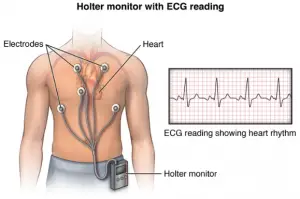Holter Monitor
It is a small, wearable device that records your heart rhythm. It is very similar to a mobile phone. A patient usually wears a Holter monitor for one to three days. The device will record all of your heart rhythms during that time. So, a Holter monitor test is usually performed after an ECG (electrocardiogram) test if ECG test is not able to give your doctor enough information about your heart’s condition.

Holter monitoring is called by other names such as Ambulatory ECG Monitoring, Ambulatory EKG Monitoring, 24-hour EKG, or Cardiac event monitoring.
Why is Holter Monitoring done?
- If you have signs or symptoms of a heart problem, such as an irregular heartbeat (arrhythmia) and traditional test ECG do not give information at that time because those symptoms occasionally occur and ECG machine is connected to you for a small duration.
- Many heart problems become noticeable only during activity, such as eating, stress, sleeping, exercise, etc.
- If your signs and symptoms suggest that an occasionally irregular heart rhythm may be causing your condition. So, a device is needed that continuously record your heart beats. This more likely to detect any abnormal heartbeats that occur during these activities.
- So, a Holter monitor is connected at the chest of the patient with leads as shown in the figure above. The ECG is recorded into the memory of the device. The doctor then analyses your ECG report from the Holter monitor and prescribed you accordingly.
- This device may be able to detect irregularities in your heart rhythm that an ECG couldn’t detect.
Excercise
Q1. What is an Ambulatory Electrocardiogram?
Ans. An ambulatory Electrocardiogram records the electrical activity of your heart while you do your usual activities. Holter monitoring is a type of ambulatory ECG. You can read more at different types of ECG.
Q2. What is the purpose of ambulatory or Holter ECG monitoring?
Ans. The purpose of ambulatory or Holter ECG monitoring is
- It is done to look for any irregular heartbeats that occur intermittently or during certain activities which are not visible during traditional ECG test. It helps in diagnosing the heart diseases that are not easily detected.
- To test the effectiveness of antiarrhythmic drugs or a pacemaker.
- To evaluate the status of patients recuperating from a heart attack.
- To detect silent ischemia (deficient blood flow to the heart without symptoms such as angina) in patients.
